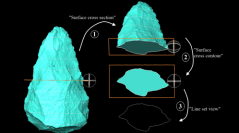

 Comptes Rendus Palevol
18 (2) - Pages 236-250
Comptes Rendus Palevol
18 (2) - Pages 236-250The analysis of the functional potential of bifaces, which are artefacts extending beyond our technical memory, is based on direct (micro-wear) or indirect approaches (experimentation, relationship between form/function, comparative ethnography). Indirect approaches are fundamental when artefacts are not well enough preserved for micro-wear analysis, which is frequent for the middle Pleistocene. This article proposes a new method based on the three-dimensional acquisition of artefact images, enabling us to measure cutting edge angles and depth of cut. This process allows us to distinguish, in particular, between cutting edges created for longitudinal or transverse cutting. The application of this analysis to bifaces from UA P3 of the “Caune de l’Arago” brings to light tools with a high functional potential for longitudinal cutting, some of which were used for incising, others for deep cutting. These results corroborate those obtained by most micro-wear analyses and present new ways of interpreting the functional potential of bifaces.
3D morphometry, Bifaces, Middle Pleistocene, Acheulean